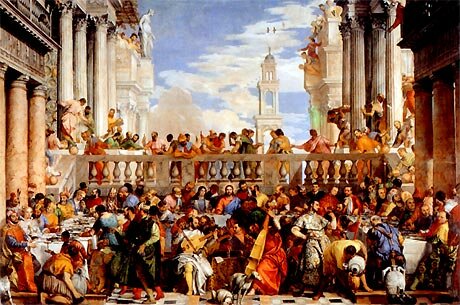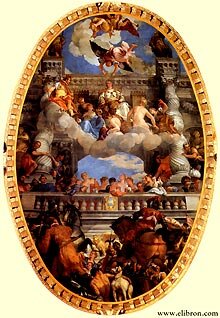

Îãëàâëåíèå ÐåôåðàòûVenetian RenaissanceVeronese (1528-1588)
He learned painting in Verona from Antonio Badile, a capable exponent of the conservative local tradition. That tradition remained fundamental to Veronese's style throughout his career, even after he moved to Venice in 1553. The painters of Verona between about 1510 and 1540 favored firm, regular volumes, strong colors that function largely in terms of contrasts, and conventionalized figures. Veronese combined these elements of the local High Renaissance style with Mannerist elements, including complex compositional schemes that often employ a “worm's-eye view” perspective and Michelangelesque figures in powerful foreshortened or contorted poses. The resulting amalgam was handled with increasing mastery in the Temptation of St. Anthony, done for the Cathedral of Mantua in 1552, and ceiling paintings (1553-54) for the Palazzo Ducale, Venice. To the fiftieth years of XVI century he formed his own style of artist, that differed from many others by the significant skill of drawing and refined color scale. (8, p. 155) The first phase of Veronese's artistic maturity, about 1555-65, is well represented by his many canvases for the Church of San Sebastiano in Venice. Their high-keyed interweavings of brilliant, luminous hues are harmonies of contrast in the tradition of Verona rather than Venetian harmonies of tone. The striking compositions often involve multileveled settings and dramatically steep perspectives, especially effective in the ceiling paintings. From this period comes Veronese's fresco decoration (circa 1561) of the Villa Barbaro at Maser, the one such cycle by him to survive. Here he extended the actual architecture of the villa (1555-59) built by Andrea Palladio with painted illusory architecture and populated these illusions with both mythological personages and fictional equivalents of the villa's real inhabitants. This painting portrays the feast at a table in the open air before a balustrade beyond which stretches a vista of classical buildings. The central group around the Christ is marginally below the middle of the painting. Before them are musicians, dogs and servants. The architectural setting behind teems with life – people walking around behind the balustrade and climbing around the pillars. Canvas is a huge size: 6,6 to 9,9 meters including 138 personages. The artist placed the Emperor of the Holy Roman Empire Charles V, French King Francis I, English Queen Maria, Turkish Sultan Suleiman I, another famous contemporary persons around Christ and Maria One of the most interesting fragments is the group of musicians in the middle. Veronese portrayed Titian, Tintoretto and himself with the musical instruments! According to one of art critics Rolf Toman: “Painters as a musicians ensemble is a very original idea, that symbolized the harmony of Venetian Art School and cooperation of artists with their constant rivalry.(7, p. 411) According with the view of George Holmes, author the fundamental work “Renaissance”: “Veronese engulfed Christ and the religious moment in a ceremonial display. More attractive is the Marriage of St Catherine.” (1, p. 242) Apart from the steps leading up to the Virgin and the two massive columns behind, presumably inspired in part by Titian’s Pesaro Altarpiece, not much use has been made of architecture. The emphasis here is on rich colour combinations, the other feature one associates with Veronese. The setting is again highly ceremonial but we are struck chiefly by the contrast between the brilliant red and blue of the Virgin’s clothes and the flowered dress of Catherine, the red hanging around the columns against the subtle colouring of the angel-filled sky. The work of Veronese's full maturity, from about 1565 to 1580, is marked by quieter, more classical compositions, an even greater ceremoniousness of tone, and still more dazzling light and color harmonies. This resplendent style is occasionally modulated into a lowered tonality, as when the artist dealt with subjects such as The Crucifixion (circa 1572). Such paintings, in which a new emotional commitment to the subject appears, multiplied toward the end of his career. By about 1583, luminous twilight replaced noonday splendor as the norm, and festivity was replaced by seriousness. The moonlit Pietà (circa 1585, Hermitage, Saint Petersburg) is an extreme example. From this period, however, comes the most overwhelming of his ceilings, The Triumph of Venice. Here, Venice, personified, floats on clouds halfway up a towering, two-tiered architectural construction thronged with people, all seen from “Venice Triumphant”, painted for the ceiling of the Hall of the Great Council of Doge’s Palace at the end of the painter’s life in 1582-84, shows Veronese at his most sumptuous. In this vast imaginary structure, with horses prancing above us, and Venice symbolized by a mature and handsome female figure, the public Veronese creates splendour for the sake of splendour. So, in other words, here is the expression of the power and God blessing of Venetian State. This work is one of the last great contributions of Chinquechento Art to the “Sacred Republic”, whose great citizen was Veronese. In the late period of Veronese art he started feel the crisis tendencies, cold showiness appeared together with formal pathetic motives though the best works belonging to this period still retained the vivid loveliness and decorative colouristic richness. The premonition of vague fear and dramatizm which are not characteristic to his state of mind appeared in his late works. His fine sophisticated colour becomesless intense. (8, p. 155). Veronese died in Venice on April 9, 1588. Although highly successful, he had little immediate influence. To the Flemish baroque master Peter Paul Rubens and to the 18th-century Venetian painters, especially Giovanni Battista Tiepolo, however, Veronese's handling of color and perspective supplied an indispensable point of departure. |
|
Êîíêóðñ ðåôåðàòîâ: Òåìà: Venetian Renaissance Àâòîð :  Êðàâöîâ Àðòóð, 11 êëàññ ÁÀÍÍÅÐÛ: |

 Paolo Veronese was one of the great masters of the Venetian school. Originally named Paolo Caliari,
Paolo Veronese was one of the great masters of the Venetian school. Originally named Paolo Caliari,
 Allegorical figures of victories, rich clothed ladies on the balcony, foreign ambassadors, among them the French King Henry III – all of them give their admiration to Venice. And, at last, the winged Angel, Her divine Patron, hoist a gold crown to Her. Clouds are just the throne for Her.
Allegorical figures of victories, rich clothed ladies on the balcony, foreign ambassadors, among them the French King Henry III – all of them give their admiration to Venice. And, at last, the winged Angel, Her divine Patron, hoist a gold crown to Her. Clouds are just the throne for Her.